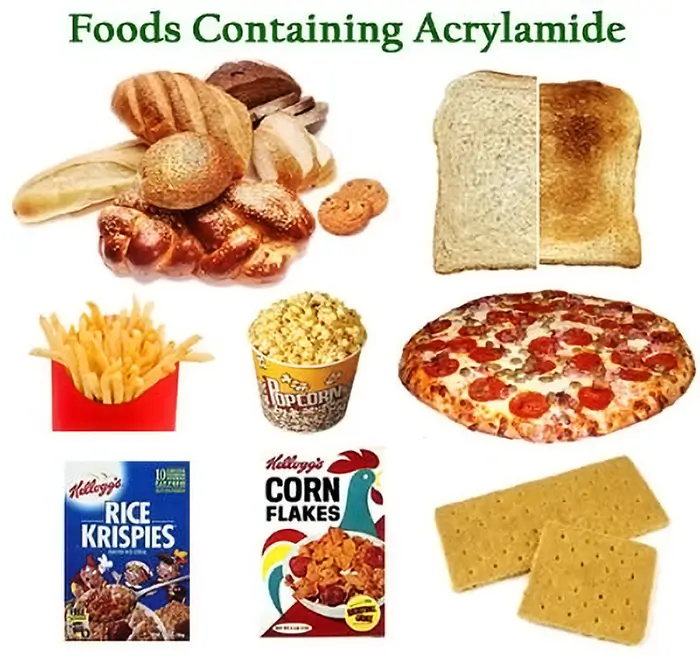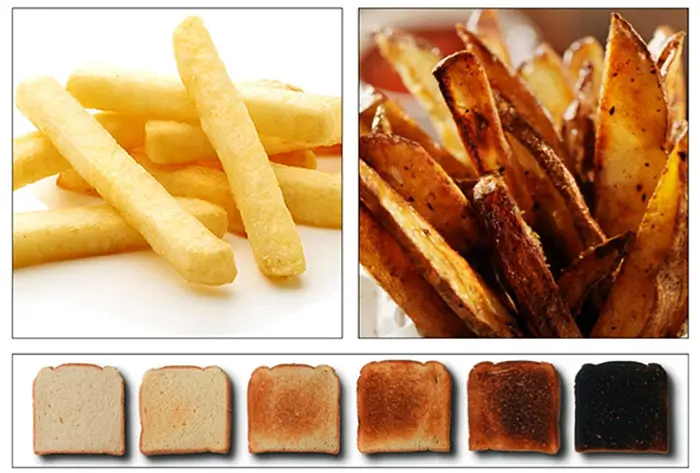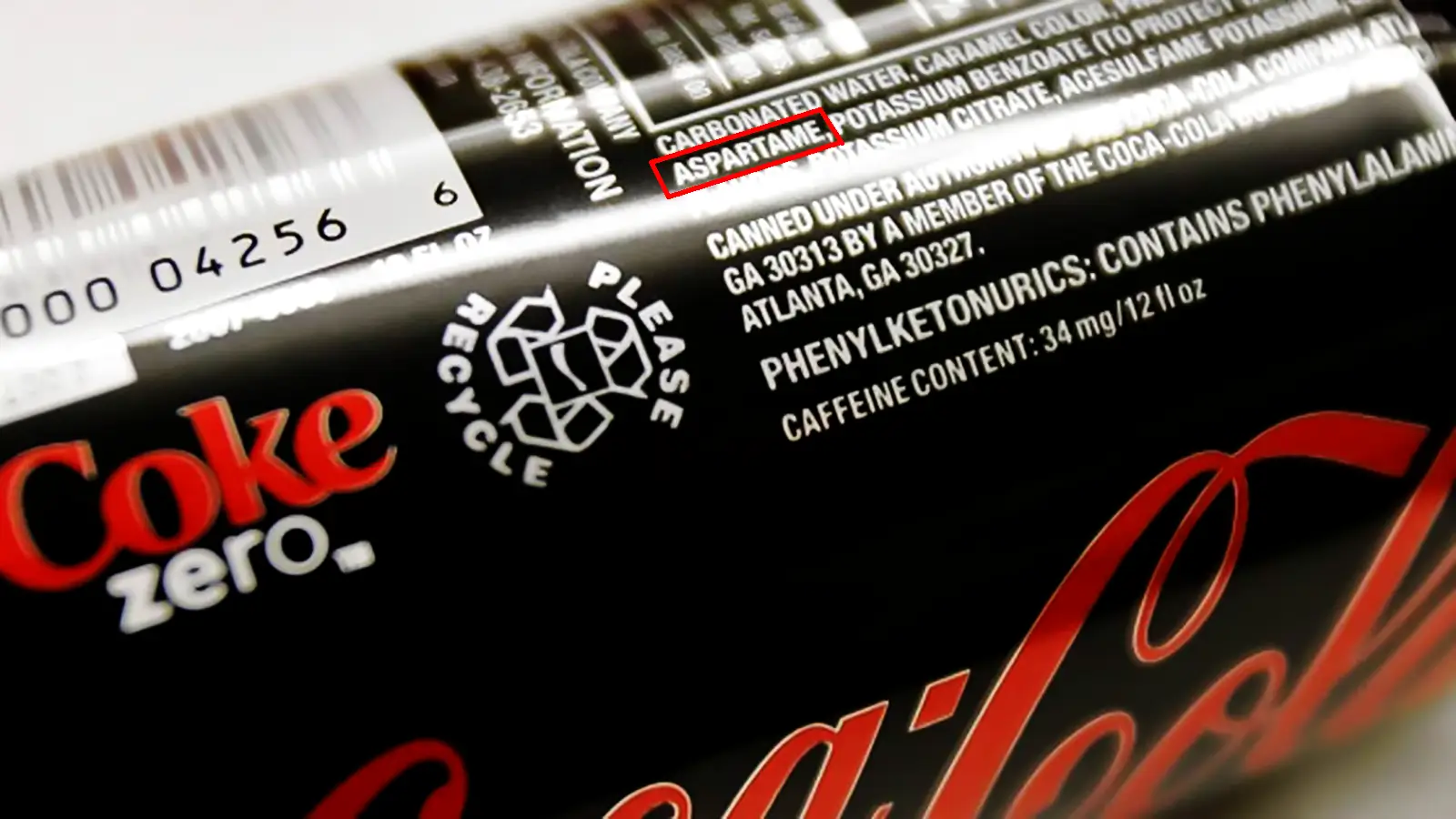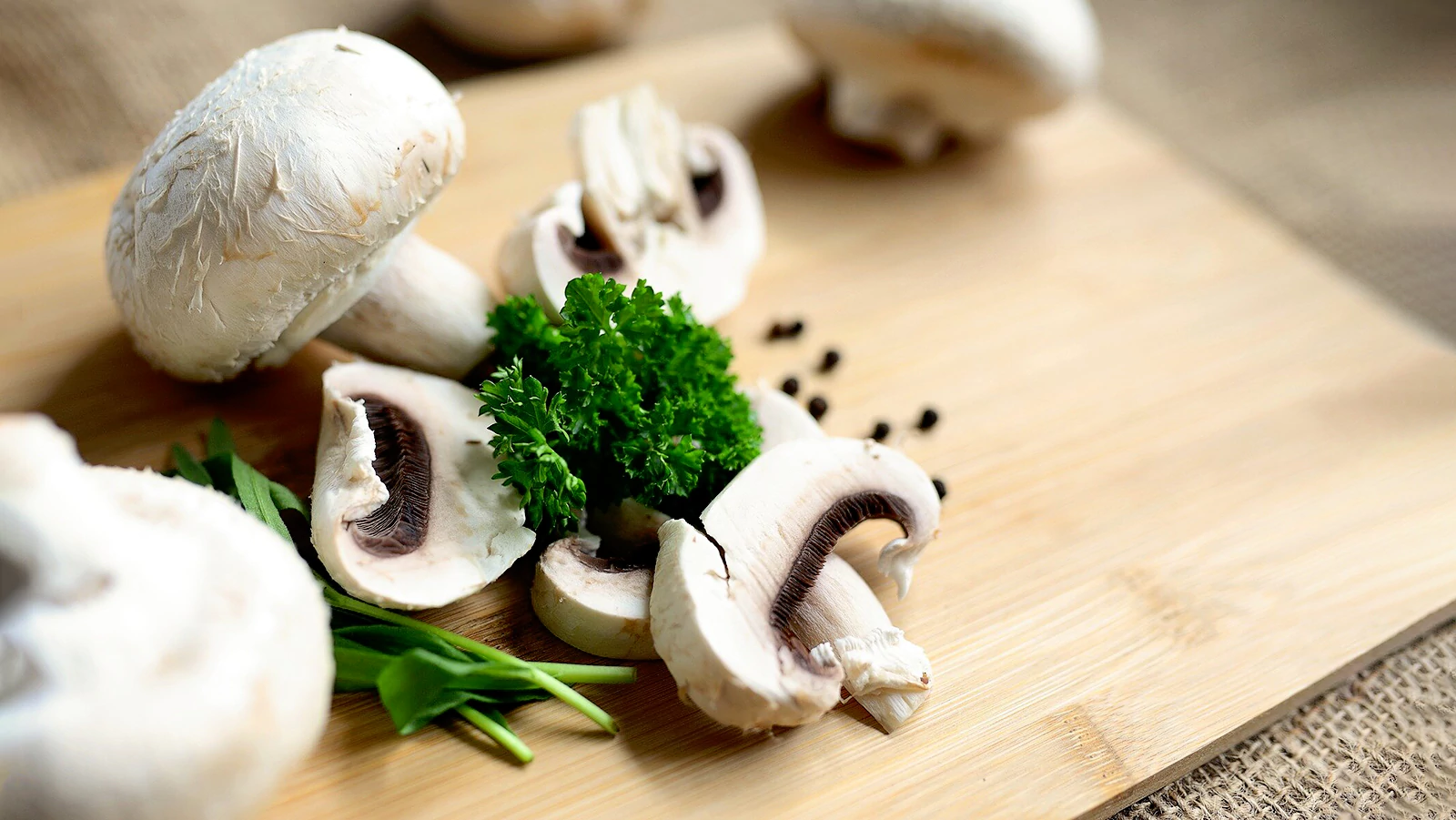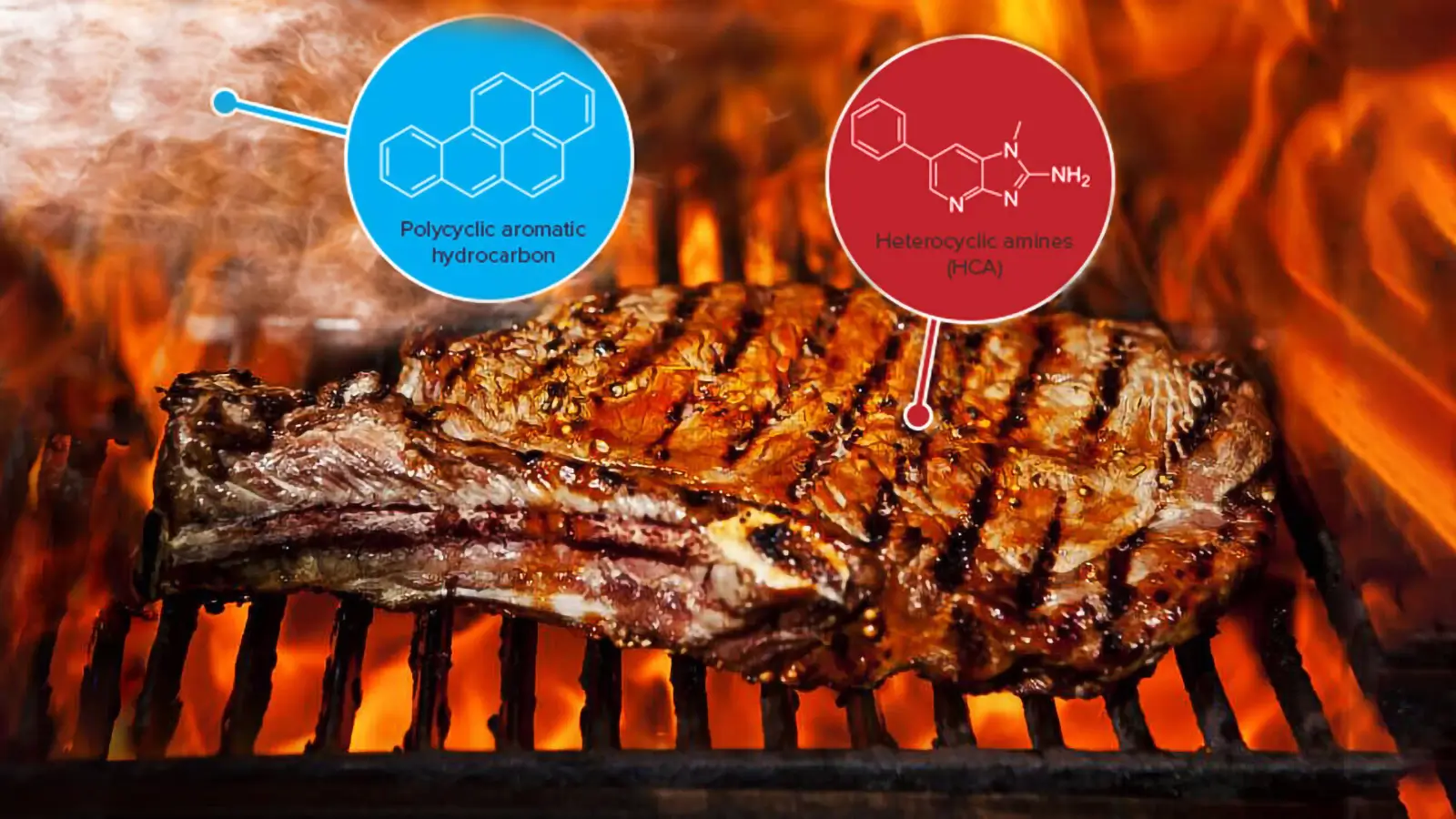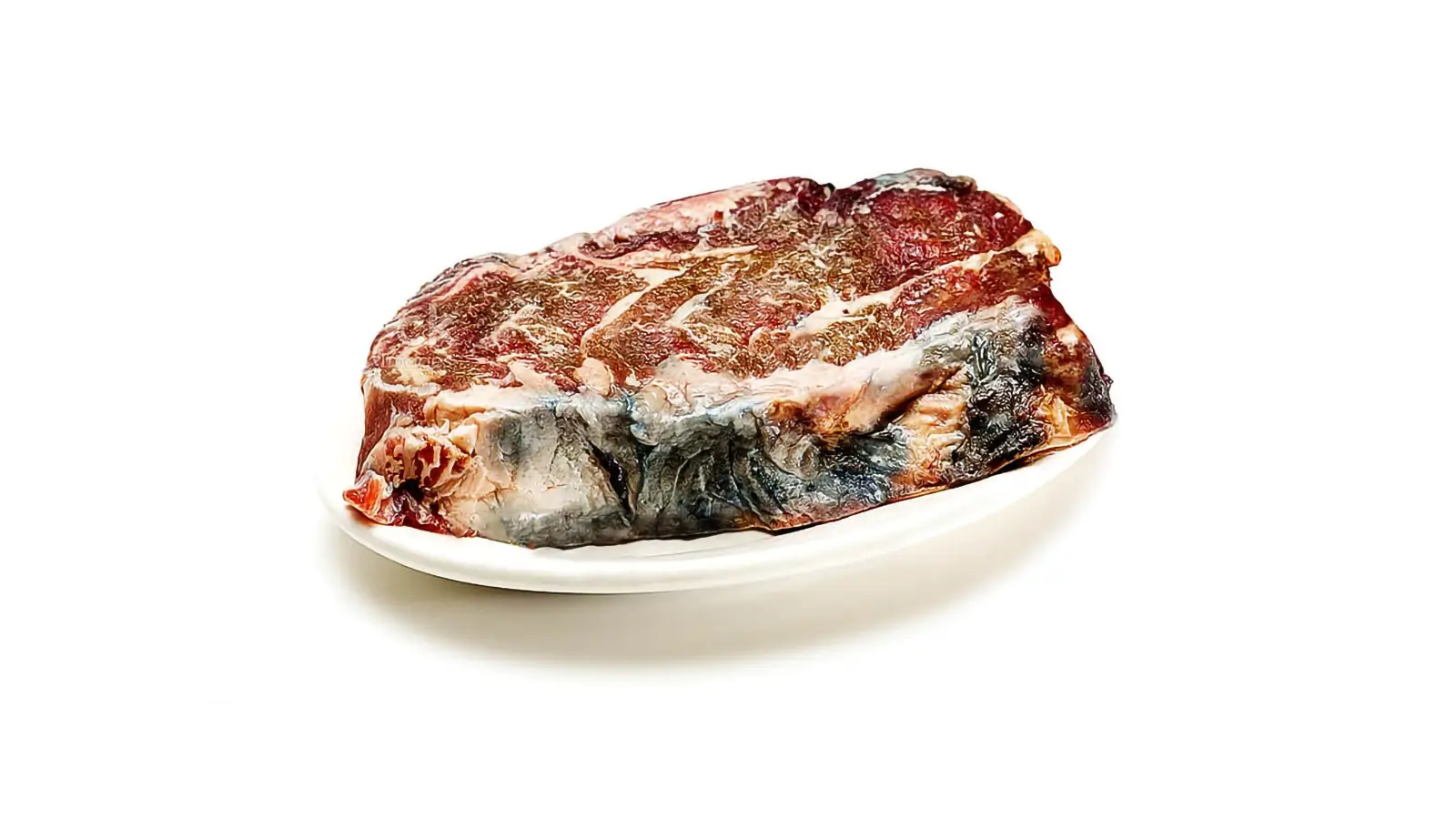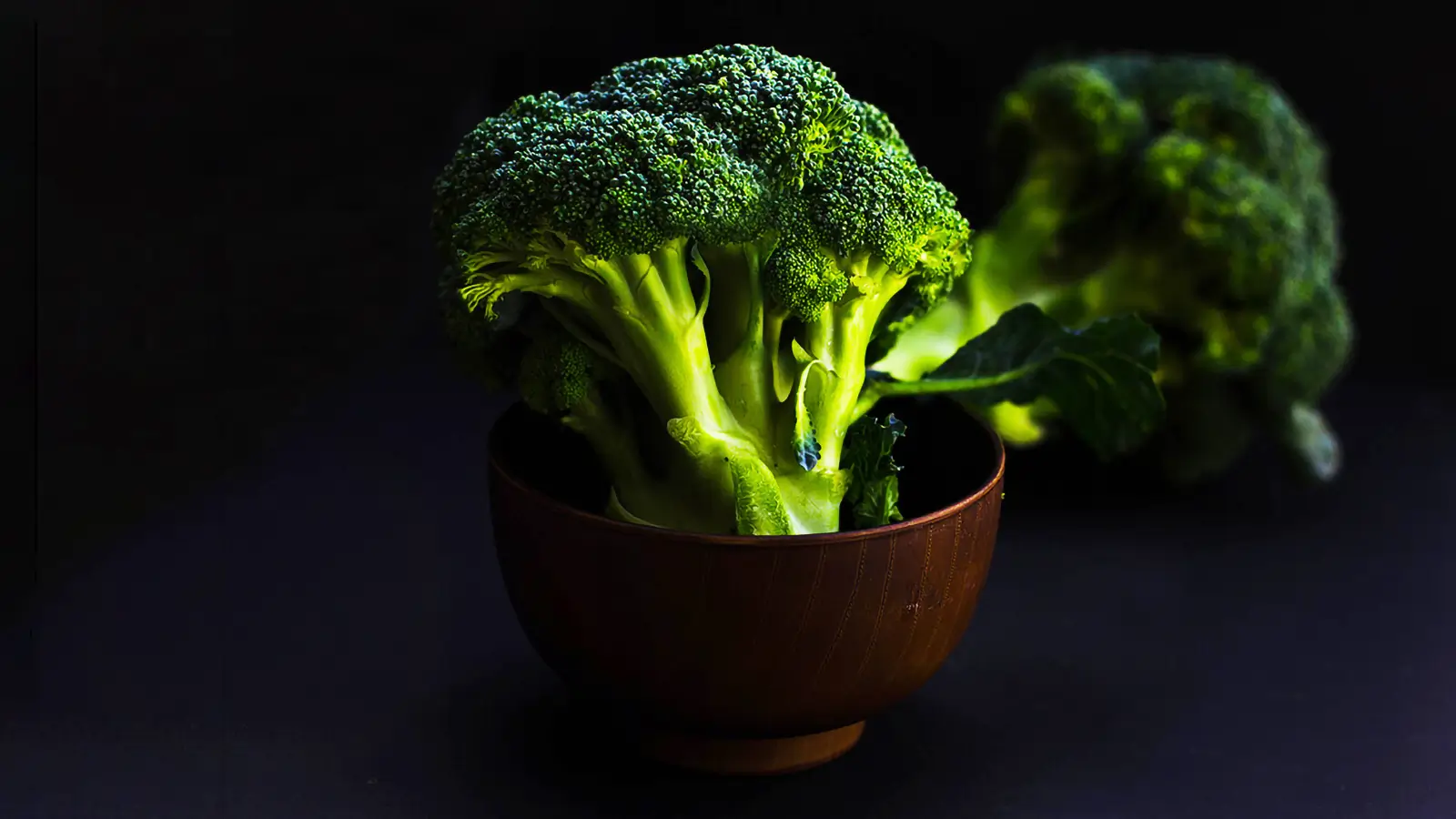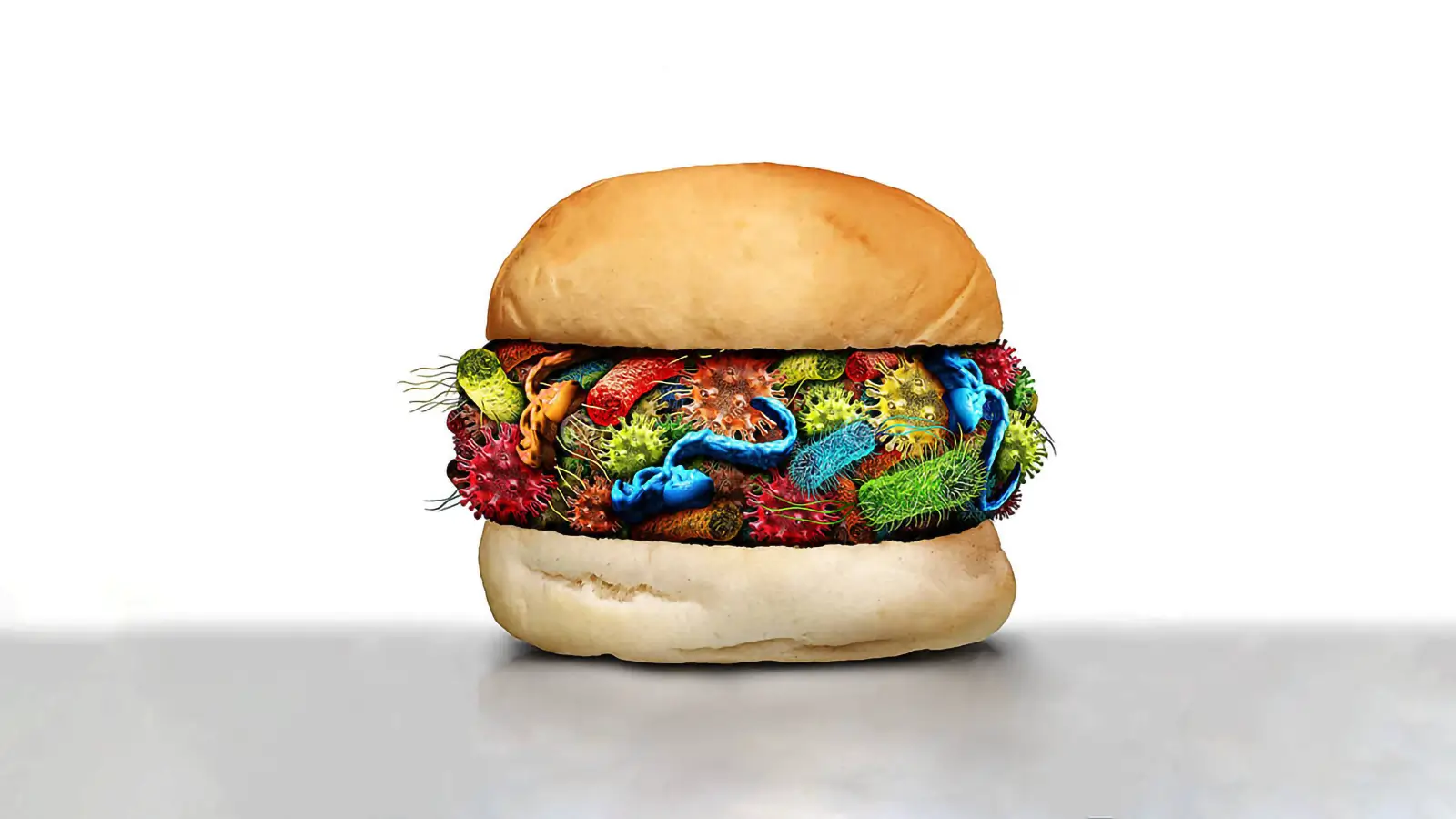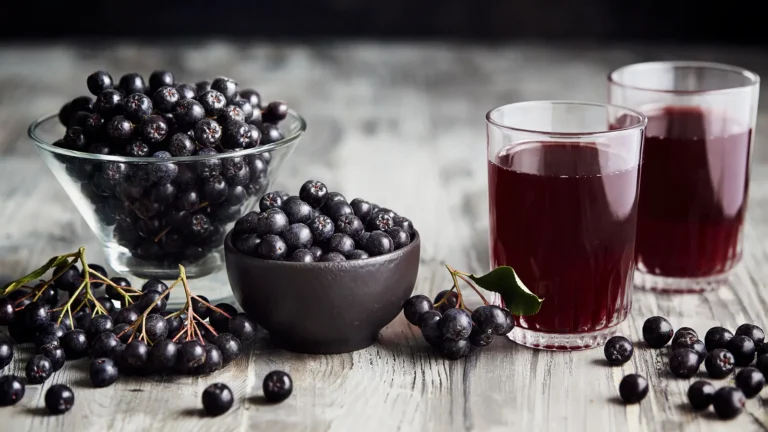アクリルアミドへの曝露 - ポテトチップス、フライドポテト、がん
アクリルアミドは、グループ 2A ヒト発がん物質として分類されています。2002年に、ポテトチップスとフライドポテトに非常に高濃度で含まれることが発見されました。
ミロス ポキミカ
によって書かれた: ミロス ポキミカ
医学的に検証した結果 Xiùying Wáng, M.D. 博士。
Updated 6月 9, 2023アクリルアミドは、プラスチック、染料、紙の製造など、多くの工業プロセスで使用されている主に工業用化学物質です。さらに、廃水、下水の処理、飲料水の処理にも利用されます。また、接着剤、食品包装、コーキングなどの多くの消費者製品にも含まれています。
米国では、アクリルアミドはグループ 2A の発がん物質として分類されており、非常に危険な物質として分類されています。その有毒な性質のため、それを使用する企業は厳格な報告要件の対象となります。
2002年に、ポテトチップスとフライドポテトに非常に高濃度で含まれることが発見されました。
濃度が非常に高かったため、通常であればこれら 2 種類の食品を子供に与えることは禁止されます。また、同じ極端なレベルではないものの、120 °C (248 °F) を超えて加熱された他のすべてのでんぷん質の食品では依然として有毒な範囲にあることも発見されました。
例えばパンなど。
加熱していない食品や茹でた食品では検出可能なレベルはありませんでした。何が起こったかというと、算出された平均アクリルアミド摂取量は神経系や生殖能力に悪影響を与えるリスクを引き起こすレベルではなく、このことから、食品中のアクリルアミド濃度は神経系に関して安全であると結論付けられました。しかし、他の環境毒素との相乗効果は計算されておらず、それに関する研究も行われていません。実験動物における既知の発がん性に基づいて、アクリルアミドのヒト発がん性についてのみ懸念が提起されました。げっ歯類の研究では、アクリルアミドへの曝露といくつかの種類のがんのリスクが関連付けられていました。
人間を対象とした研究の証拠では、腎臓がん、乳がん、子宮内膜がん、卵巣がん、前立腺がんとの関連が示されています。
では、加熱するとアクリルアミドが生成されるのでしょうか? アスパラギンという名前のアミノ酸(タンパク質の構成要素)があります。植物性タンパク質を含むあらゆる種類のタンパク質にも含まれています。ジャガイモの種類によっては、他の既知の食品よりも多くの量が含まれています。
特定のデンプンまたは糖の存在下でアスパラギンが高温で加熱され始めると、アスパラギンがアクリルアミドに変化する化学反応が起こります。曝露量を減らしたい場合は、煮沸や電子レンジなどの低温調理方法を使用できます。焼く、揚げる、炙るなどの高温調理方法では、アミノ酸自体の濃度、でんぷんの濃度、調理の温度と時間に応じてアクリルアミドが生成されます。
調理温度が 120 ℃を超えると、調理時間が長くなり、アクリルアミドの生成が増加します。
自然界には、食べ物に対して揚げ物をするような動物はいません。それは不自然な過程であり、進化に関する新しい発明であるため、その毒性に対して十分な対処ができていません。アクリルアミドは摂取されると、シトクロム P450 酵素系によって処理されてグリシダミドに変換され、解毒されます。私たちの代謝経路はある程度の解毒を助けてくれますが、それでも肝臓の解毒能力に負担がかかり、肝臓の解毒能力が間に合わなくなる可能性があります。
たとえば、特に幼い子供の場合、ポテトチップスをたくさん食べると、これらの解毒経路に過度のストレスがかかり、この物質への過剰な暴露により健康上のリスクにさらされる可能性があります。私たちはシトクロム P450 酵素系を持っており、ホモ・エレクトスはデンプンの豊富な野菜の一部をローストしていた可能性があるため、私たちのヒト族の祖先がこの化学物質に曝露されていた可能性はありますが、過剰な環境でこの化学物質に曝露された可能性は低いです。今日の私たちのレベルと同じです。
揚げると、食品に含まれる多くの分子の分子の一貫性が破壊されます。私たち自身のタンパク質や細胞の構成要素であるアミノ酸が損傷すると、問題が発生します。損傷が部分的である場合、私たちの体は実際に損傷を受けていることに気づかずに、これらの損傷したアミノ酸を細胞に取り込みます。その結果、これは突然変異誘発性および発がん性の影響を及ぼします。揚げたり焼いたりすると、熱安定性のない油(オメガ 3 6 9)も破壊され、油が酸化されて酸化し、発がん性も高まります。いくつかの研究では、揚げ物と一部の種類のがんとの間に有意な相関があることが示されています。がんにかかっている場合は、茹でる以外の食品加工を避けるのが合理的です。高温で生成される可能性のある有毒で発がん性のある化学物質のリストは膨大です。
アクリルアミドを避けたい場合は、トーストした穀物、ポテトチップス、フライドポテト、トーストした小麦シリアル、クッキーやクラッカー、ローストした穀物ベースのコーヒー代替品、ローストしたカカオ豆(およびチョコレート、ヌテラ、その他のココア)を摂取しないでください。作ったもの)。一部の缶詰の種なし黒オリーブも、アクリルアミドへの曝露に関してこの高リスクのカテゴリーに分類される可能性があります。
許容量は体重1キログラムあたり2,6マイクログラムに設定されている。体重70kgの人間の場合、182マイクログラムである。子供の場合はそれよりもはるかに少ない。そして私は、この制限値は意図的に高く設定されていると主張する。この制限値を低く設定することは、私たちが店やレストランで食べている様々な食品を法的に強制回収することを意味する。マクドナルドのラージポテトには82マイクログラム含まれている。現在の許容値でも、たとえばマクドナルドの大盛りポテトを体重35kg以下の子供に販売することを法的に制限することが求められる。食事性アクリルアミドへの暴露を減らしたければ、上記の食品の摂取を制限する必要がある。.
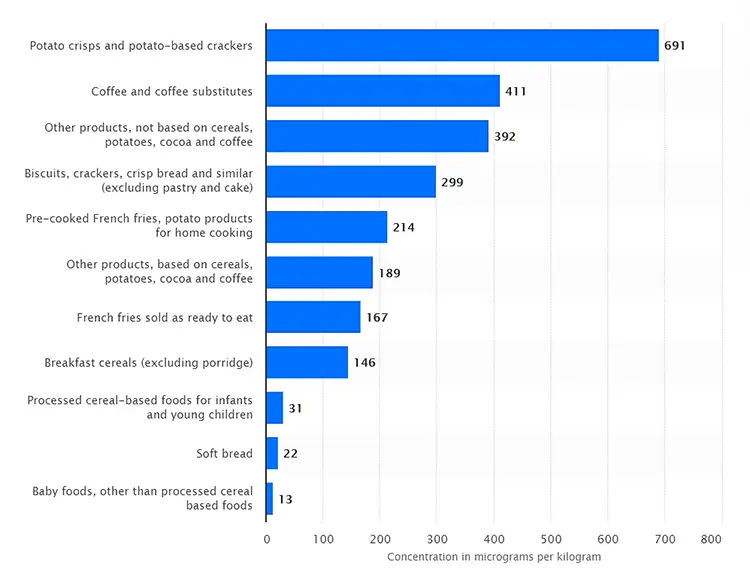
2015 年に英国 (UK) で食品中に検出されたアクリルアミドの平均濃度 (1 キログラムあたりのマイクログラム)。
Statista Research Division 発行、2016 年 8 月 1 日
しかし、またしても私たちは何かを忘れています。
揚げたり焼いたりした食べ物でも同様の反応が起こります。でんぷん質だけではありません。私たちが動物性食品を食べると、他の化学物質が生成されるだけで、同じプロセスが起こります。それは不自然な行為です。ハルマネと本態性振戦の関係についてはすでに述べました。多環式芳香族炭化水素 (PAH) と複素環式アミン (HCA) は、種を問わず、筋肉肉だけでなくあらゆる動物組織を高温調理で調理すると生成します。直火で直接グリルしたりフライパンで焼いたりすると、17 種類の異なる複素環アミン (HCA) が生成されます。HCA と PAH は、とりわけヒトの発がん物質であることが証明されています。複素環は形状を表すだけですが、加熱の過程で分子構造が損傷したアミノ酸であることに変わりはなく、体はそれらが損傷していることを完全には認識しません。
生涯にわたって、環境内の他の毒素や変異原物質にさらされることを考えると、さらに追加することは得策ではありません。私たちの肝臓が解毒しなければならない何千もの異なる毒素は発がん性ではないかもしれませんが、新しい環境ではその負荷自体が問題となります。私たちが汚染のない自然のままの状態で進化した過去のきれいな自然の中で、私たちの体は依然として自然に発生する毒素の一部に対処しなければなりませんでしたが、現在私たちが抱えている他の化学物質で過剰に負荷をかけられることはありませんでした。したがって、私たちの新しい生息地では、すべての毒素への曝露をできるだけ減らすことを考えなければなりません。すべての毒素を減らすことはできないからです。しかし、回避できるものは回避すべきであり、致命的ではない毒素であっても、過負荷を軽減するために回避する必要があります。肝臓の負荷が過剰になると、より危険な毒素が蓄積し、私たちの細胞にダメージを与えることになります。食物連鎖の低い位置に行く、オーガニックの食事をする、保存料を避ける、揚げ物や焼きすぎを避ける、自然の毒素を避ける、 きれいな水を飲む は始まりにすぎません。
参考文献:
本からの抜粋ポキミツァ、ミロス ビーガンに行きますか?科学の復習パート 1. Kindle版、 アマゾン、2018年。
- ラインバック、デヴィッド R 他 「食品中のアクリルアミド:科学のレビューと今後の検討事項」 食品科学技術の年次レビュー 巻。3 (2012): 15-35。 doi:10.1146/annurev-food-022811-101114
- ミシャラク、ジョアンナ 他 「市場で購入される食品のアクリルアミドと熱処理指数」 環境研究と公衆衛生の国際ジャーナル Vol. 16.23 4724。11 月 27 日 2019年、 土井:10.3390/ijerph16234724
- チェン、ミンジェン 他 「生涯超過癌リスク評価のためのフライドポテト中のアクリルアミド濃度を推定するための統計的回帰モデル。」 食品および化学毒性学 : 英国産業生物学研究協会のために発行された国際ジャーナル 巻。50,10 (2012): 3867-76。 土井:10.1016/j.fct.2012.07.010
- リップワース、ローレンら。「食事によるアクリルアミド摂取とがんのリスクに関する疫学研究のレビュー」 European Journal of Cancer Prevention : 欧州がん予防機関 (ECP) の公式雑誌 巻。21,4 (2012): 375-86。 土井:10.1097/CEJ.0b013e3283529b64
- ストット・ミラー、マルニら。「揚げ物の摂取と前立腺がんのリスク」 前立腺 巻。73,9 (2013): 960-9。 土井:10.1002/pros.22643
- Hogervorst、Janneke G et al. 「食事からのアクリルアミド摂取と腎細胞がん、膀胱がん、前立腺がんのリスク」 アメリカの臨床栄養学雑誌 巻。87,5 (2008): 1428-38。 土井:10.1093/ajcn/87.5.1428
関連記事
栄養と健康について何か質問はありますか?
ぜひご意見をいただき、次回の投稿でお答えしたいと思います。皆様のご意見とご意見に感謝しており、すぐにご連絡をお待ちしております。私もあなたを招待します フォローする Facebook、Instagram、Pinterestでダイエット、栄養、健康に関するコンテンツをご覧ください。そこにコメントを残して、他の健康愛好家とつながり、あなたのヒントや経験を共有し、私たちのチームやコミュニティからサポートや励ましを得ることができます。
この投稿があなたにとって有益で楽しいものであり、学んだ洞察を生かす準備ができていることを願っている。この投稿が役に立ったと思われた方は シェアする 友人や家族など、その恩恵にあずかれるかもしれない人たちと一緒に。誰が健康の旅にガイダンスやサポートを必要としているかわからないのですから。
– あなたはおそらくそれも好きでしょう –

栄養について学ぶ
ミロス・ポキミカは、自然医学の医師、臨床栄養士、医療健康と栄養のライター、栄養科学アドバイザーです。書籍シリーズの著者 ビーガンに行きますか?科学の復習また、自然健康サイト「GoVeganWay.com」を運営している。
医療上の免責事項
GoVeganWay.com では、最新の栄養と健康関連の研究のレビューをお届けします。提供される情報は著者の個人的な意見を表すものであり、専門的な医学的アドバイス、診断、または治療に代わることを意図または暗示するものではありません。提供される情報は情報提供のみを目的としており、資格のある医師または医療提供者の相談、診断、および/または治療に代わるものとして機能することを意図したものではありません。GoVeganWay.com で読んだことや GoVeganWay.com を通じてアクセスしたことを理由に、専門家の医学的アドバイスを無視したり、医療治療を受けるのを遅らせたりしないでください。
認可された医師に相談する前に、GoVeganWay.com で読んだ内容の結果としてライフスタイルの変更や変更を決して適用しないでください。
医療上の緊急事態が発生した場合は、直ちに医師または 911 に電話してください。GoVeganWay.com は、内部で言及されている特定のグループ、組織、検査、医師、製品、手順、意見、またはその他の情報を推奨または承認しません。
編集者のおすすめ –
ミロス・ポキミカは健康・栄養ライターであり、栄養科学アドバイザーである。書籍シリーズの著者。 ビーガンに行きますか?科学の復習また、自然健康サイト「GoVeganWay.com」を運営している。
最新記事 -
トップヘルスニュース — ScienceDaily
- Why consciousness exists at all12月 15, 2025 に
Consciousness evolved in stages, starting with basic survival responses like pain and alarm, then expanding into focused awareness and self-reflection. These layers help organisms avoid danger, learn from the environment, and coordinate socially. Surprisingly, birds show many of these same traits, from subjective perception to basic self-awareness. This suggests consciousness is far older and more widespread than once believed.
- AI found a way to stop a virus before it enters cells12月 15, 2025 に
Researchers discovered a hidden molecular “switch” that herpes viruses rely on to invade cells. By combining AI, simulations, and lab experiments, they identified and altered a single amino acid that shut down viral entry. What once might have taken years was achieved far faster using computational tools. The findings open new possibilities for designing future antiviral treatments.
- New study shows some plant-based diets may raise heart disease risk12月 15, 2025 に
Researchers tracking over 63,000 adults found that high-quality, minimally processed plant foods significantly reduce cardiovascular risk. But when those plant foods are ultra-processed, the advantage disappears—and can even backfire. Some ultra-processed plant diets increased risk by 40%. The study urges a shift toward whole, naturally nutrient-rich plant foods.
- These simple habits could make your brain 8 years younger, study finds12月 15, 2025 に
New research shows that your brain’s “true age” can shift dramatically depending on how you live, with optimism, restorative sleep, stress management, and strong social support acting like powerful anti-aging tools. Using advanced MRI-based brain-age estimates, scientists found that people with multiple healthy lifestyle factors had brains up to eight years younger than expected — even among those living with chronic pain.
- Anxiety and insomnia linked to sharp drops in key immune cells12月 15, 2025 に
Natural killer cells act as the immune system’s rapid-response team, but the stress of anxiety and insomnia may be quietly thinning their ranks. A study of young women in Saudi Arabia found that both conditions were linked to significantly fewer NK cells—especially the circulating types responsible for destroying infected or abnormal cells. As anxiety severity increased, NK cell levels dropped even further, suggesting a stress-driven weakening of immune defenses.
- Cannabis compounds show unexpected power against ovarian cancer12月 15, 2025 に
Scientists have discovered that key compounds from cannabis—CBD and THC—show surprisingly strong effects against ovarian cancer cells. Used together, they slow cell growth, reduce colony formation, and may even block the cancer’s ability to spread. Even more promising, the treatment caused minimal harm to healthy cells and appears to work by restoring a disrupted signaling pathway that fuels tumor growth.
- Mayo Clinic neurosurgeon reveals 8 back pain myths to stop believing12月 15, 2025 に
Back pain is wrapped in persistent myths, but many are far from the truth. From misconceptions about heavy lifting and bed rest to confusion over posture, exercise, and surgery, Dr. Meghan Murphy breaks down what really causes pain and what actually helps. Her insights reveal that everyday habits, movement, and smart prevention often make a bigger difference than people realize.
パブメッド、 #ビーガンダイエット –
- Healthful and Unhealthful Plant-Based Diets and Their Association with Cardiometabolic Targets in Women Diagnosed with Breast Cancer: A Cross-Sectional Analysis of a Lifestyle Trial12月 11, 2025 に
CONCLUSIONS: Maintaining cardiometabolic risk factors within normal ranges is clinically relevant in BCS, and this may be more likely when a plant-based diet is consumed, especially if low in unhealthy plant foods.
- Dietary and Lifestyle Patterns and Their Associations with Cardiovascular and Inflammatory Biomarkers in Vegans, Vegetarians, Pescatarians, and Omnivores: A Cross-Sectional Study12月 11, 2025 に
Background: Plant-based diets are associated with reduced cardiometabolic risk, yet the influence of lifestyle behaviors on these benefits remains insufficiently understood. Objective: To assess the combined impact of dietary patterns and lifestyle behaviors on body composition, lipid profiles, and inflammatory biomarkers in healthy young adults. Methods: In this cross-sectional study, 155 participants aged 18-39 years were categorized into four dietary groups: vegans (n = 48), vegetarians (n […]
- Functional and Nutritional Properties of Lion’s Mane Mushrooms in Oat-Based Desserts for Dysphagia and Healthy Ageing12月 11, 2025 に
Hericium erinaceus (Lion’s Mane mushroom) is a medicinal species recognised for its neuroprotective and antioxidant properties. This study investigated its potential as a functional ingredient in oat milk-based desserts formulated for individuals with dysphagia. Freeze-dried Lion’s Mane powder (LMP), containing high-quality protein (~16%, amino acid score 88%), dietary fibre (~31%), and phenolic compounds (72.15 mg GAE/g), was incorporated at varying levels using gelatin or iota-carrageenan […]
- “A football team with no midfield”: A qualitative analysis of anti-vegan stigma in Italy12月 7, 2025 に
A growing body of research has demonstrated the prevalence of unfavourable attitudes towards individuals who adhere to a vegan diet and has provided empirical evidence to support the existence of an anti-vegan ideology. The present study aims to contribute to extant knowledge by examining the social perception of veganism and vegans in Italy. Italy is a nation characterised by a traditional culture of food that serves as a significant catalyst for collective identification and national pride….
- Plant-based dietary index on the Mediterranean and a vegan diet: a secondary analysis of a randomized, cross-over trial12月 5, 2025 に
CONCLUSION: These findings suggest that, replacing animal products even with the “unhealthful” plant-based foods on a vegan diet was associated with weight loss.
ランダムな投稿 –
おすすめの投稿 -
PubMed の最新情報、 #植物ベースの食事 –
- Identification of effective plant-based oils for use in aquafeed: An evaluation of impact on gamete quality and developmental success using zebrafish (Danio rerio) as a screening organismによって Seyed-Mohammadreza Samaee 12月 14, 2025 に
To evaluate the effectiveness of zebrafish as a screening system for identifying appropriate plant oils (POs) for aquafeed, Artemia nauplii (AN) were enriched with three single- cultivar olive oils (OO): Koroneiki, Parseh, and Arghavan. The resulting AN (ANKor, ANPar, ANArg, and AN36 [36 h starved AN, control]) were then fed to 360 fish (3.5 cm) for one month. The fatty acid (FA) profile of the AN was reflected in the ova and influenced both sperm motility and density, which in turn affected […]
- The Effect of Dietary Interventions on Human Vascular Function in the Context of Acute Psychological Stress: A Scoping Reviewによって Rosalind Baynham 12月 14, 2025 に
Episodes of acute psychological stress increase the risk for cardiovascular diseases, partially through stress-induced impairments in vascular function. During psychologically stressful periods, individuals are more likely to consume unhealthy foods and fewer fruits and vegetables. Yet, the impact of dietary choices and their nutritional composition on vascular function in the context of psychological stress is unclear. In this scoping review, comprehensive database searches were carried out […]
- Plant-based diets, gut microbiota, blood metabolome, and risk of colorectal, liver and pancreatic cancers: results from a large prospective cohort study of predominantly low-income Americansによって Fangcheng Yuan 12月 14, 2025 に
CONCLUSIONS: A diet high in healthy plant foods and low in animal foods was inversely associated with liver cancer risk and with CRC risk among screening-naïve participants. These associations may be partly mediated through gut microbiota and systemic metabolism.
- Vegetarian diet and likelihood of becoming centenarians in Chinese adults aged 80 years or older: a nested case-control studyによって Yaqi Li 12月 14, 2025 に
CONCLUSIONS: Targeting individuals of advanced age (80+ years) in China, we found that individuals following vegetarian diet had lower likelihood of becoming centenarians relative to omnivores, underscoring the importance of a balanced high-quality diet with animal- and plant-derived food composition for exceptional longevity, especially in the underweight oldest-old.
- Priority of nutrition and exercise in depression management: triangulating mini-review of past and recent evidence with clinical practice guidelinesによって Shannon Rogers 12月 14, 2025 に
CONCLUSIONS: Disparities that exist in leading depression management guidelines vis-à-vis inclusion of evidence-informed nutrition and PA/PE recommendations, warrant reconciliation. Evidence supporting anti-depressant WFPB nutrition and limiting pro-inflammatory animal-sourced food and UPF and supporting anti-inflammatory aerobic exercise and resistance training warrants being translated into national/international depression management guidelines as consistently as recommendations for…
- The effect of a diet based on vegetable and dairy protein on biochemical and functional indicators of sarcopenia in patients with liver cirrhosis: a randomized controlled trialによって Mahdiyeh Taghizadeh 12月 13, 2025 に
CONCLUSIONS: In conclusion, a vegetable and dairy protein-based diet effectively inhibited significant elevations in ammonia levels compared to the standard diet in persons with liver cirrhosis; however, anthropometric parameters and muscle function did not differ between two groups.
